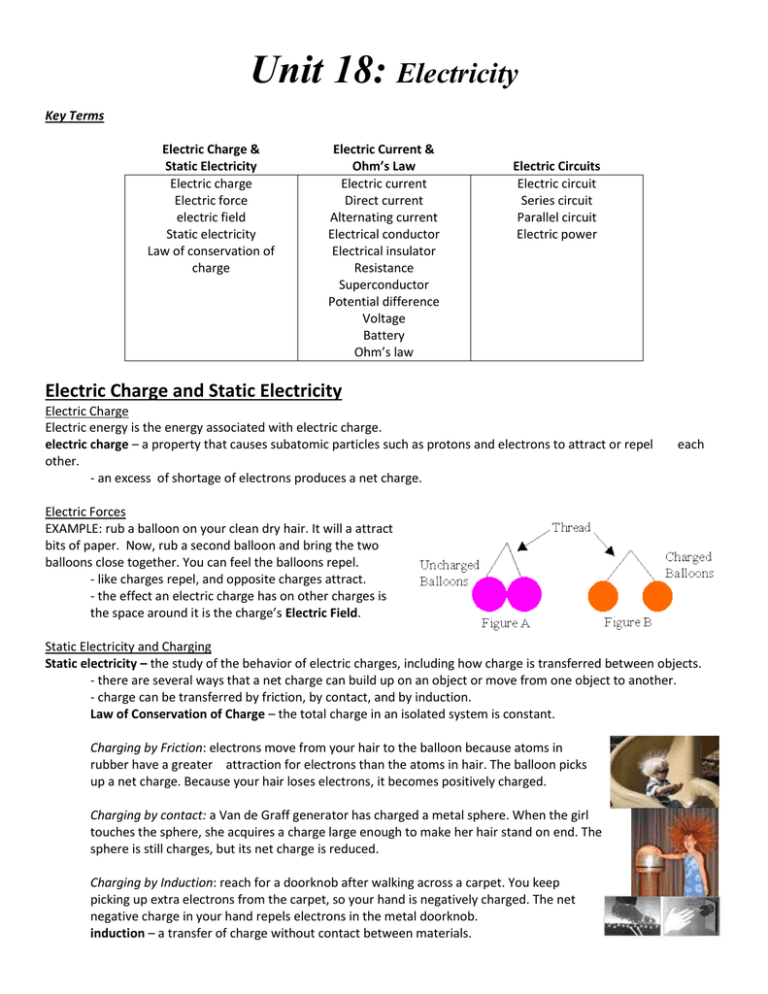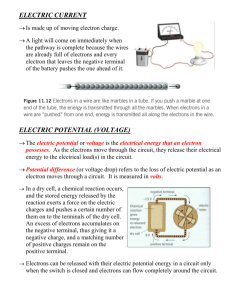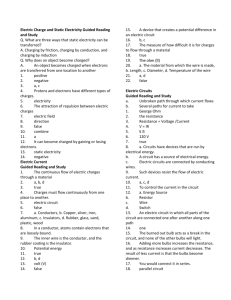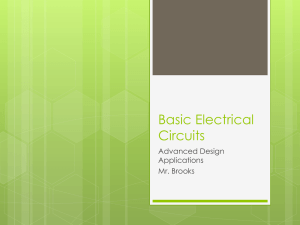Electricity - MrJohnsClass
advertisement

Unit 18: Electricity Key Terms Electric Charge & Static Electricity Electric charge Electric force electric field Static electricity Law of conservation of charge Electric Current & Ohm’s Law Electric current Direct current Alternating current Electrical conductor Electrical insulator Resistance Superconductor Potential difference Voltage Battery Ohm’s law Electric Circuits Electric circuit Series circuit Parallel circuit Electric power Electric Charge and Static Electricity Electric Charge Electric energy is the energy associated with electric charge. electric charge – a property that causes subatomic particles such as protons and electrons to attract or repel other. - an excess of shortage of electrons produces a net charge. each Electric Forces EXAMPLE: rub a balloon on your clean dry hair. It will a attract bits of paper. Now, rub a second balloon and bring the two balloons close together. You can feel the balloons repel. - like charges repel, and opposite charges attract. - the effect an electric charge has on other charges is the space around it is the charge’s Electric Field. Static Electricity and Charging Static electricity – the study of the behavior of electric charges, including how charge is transferred between objects. - there are several ways that a net charge can build up on an object or move from one object to another. - charge can be transferred by friction, by contact, and by induction. Law of Conservation of Charge – the total charge in an isolated system is constant. Charging by Friction: electrons move from your hair to the balloon because atoms in rubber have a greater attraction for electrons than the atoms in hair. The balloon picks up a net charge. Because your hair loses electrons, it becomes positively charged. Charging by contact: a Van de Graff generator has charged a metal sphere. When the girl touches the sphere, she acquires a charge large enough to make her hair stand on end. The sphere is still charges, but its net charge is reduced. Charging by Induction: reach for a doorknob after walking across a carpet. You keep picking up extra electrons from the carpet, so your hand is negatively charged. The net negative charge in your hand repels electrons in the metal doorknob. induction – a transfer of charge without contact between materials. Static Discharge Static discharge occurs when a pathway through which charges can move forms suddenly. - charges will not travel through air from your hand to the doorknob. But air becomes charged suddenly when the gap between your fingers and the doorknob is small. This air provides a path for electrons to flow from your hand to the doorknob. Electric Current and Ohm’s Law Electric Current – the continuous flow of electric charge - the SI unit of electric current is the ampere ( A ), or amp, which equals 1 coulomb per second. - there are 2 types of current: direct and alternating. direct current – (DC)charge flows only in one direction. - flashlights and most battery operated devices use DC. alternating current – a flow of electric charge that regularly reverses its direction - your home Conductors and Insulators electrical conductor – a material through which charge can flow easily. electrical insulator – a material through which charge cannot flow easily. Enduring Understandings: Some materials allow electricity to flow easily while others do not. What types of materials allow electricity to flow and what types do not? A metal is made up of ions in a lattice. The ions are not free to move. But each ion has one or more electrons that are not tightly bound to it. These free electrons can conduct charge. Most materials do not easily conduct charge because they don’t have free electrons. Metals such as copper and silver are good electrical conductors. Wood, plastics, rubber, and air are good electrical insulators. Resistance – opposition to the flow of charges in a material. - the SI unit of resistance is the ohm. - resistance is lower if you make a wire thicker because more electrons can flow through a thicker wire. - a material’s thickness, length, and temperature affect its resistance. GREATER Resistance: longer wires – the charges travel farther temperature increases – electrons collide more often. LESS Resistance: shorter wire – charge travels a shorter distance temperature decreases – electrons collide less often superconductor – a material that has almost zero resistance when it is cooled to low temperatures. - the best superconductors found thus far must be cooled to about 138K Why are some materials classified as semiconductors? semiconductor - material has an electrical conductivity value between a conductor, such as copper, and an insulator, such as glass. - allow electricity to flow better than insulators but not as well as conductors. - Semiconductors are the foundation of modern electronics. increase conductivity decrease conductivity increase temperature decrease temperature - this is opposite to that of a metal What are some uses of semiconductors? Semiconductor devices can display a range of useful properties: - passing current more easily in one direction than the other - showing variable resistance - sensitivity to light or heat EXAMPLES: silicon, germanium USES: diodes, transistors, solar cells Enduring Understandings: The amount of electricity that flows through a conductor depends on several factors What are the factors that affect the flow of electricity through a conductor? GREATER Resistance: longer wires – the charges travel farther temperature increases – electrons collide more often. thickness reduced – less electrons can flow LESS Resistance: shorter wire – charge travels a shorter distance temperature decreases – electrons collide less often thickness increases – more electrons can flow What is electrical power? Voltage In order for a charge to flow in a conductive wire, the wire must be connected in a complete loop that includes a source of electrical energy. Potential Difference – (voltage) the difference in electrical potential energy between two places in an electric field - measured in joules per coulomb, or volt. Voltage Source battery – a device that converts chemical energy to electrical energy - have terminals that can connect to wires in a circuit. - one terminal is positive and one is negative - a voltage drop, or potential difference, is maintained across the terminal. EXAMPLE: the voltage drop is a 9-volt battery is about 9 volts. Ohm’s Law – the voltage ( V ) in a circuit equals the product of the current ( I ) and the resistance ( R ). - the unit of resistance, the ohm, is named after the German scientist Georg Ohm (1789-1854) - he determined how resistance and current affect voltage. - he discovered that voltage is not the same everywhere in a circuit. - he hypothesized that resistance reduces voltage. V=I xR or I = V/R V = voltage ( volts ) I = current ( A ) R = resistance ( ohm ) - increasing the voltage increases the current. Keeping the same voltage and increasing the resistance decreases the current. Electric Circuit electric circuit – a complete path through which charge can flow. - circuit diagrams use symbols to represent parts of a circuit, including a source of electrical energy and devices that are run by the electrical energy. Series circuit – charge has only one path through which it can flow. - if one light bulb goes out in a series circuit, it becomes an open circuit. - if one element stops functioning in a series circuit, none of the elements can operate. Parallel circuit – an electrical circuit with two or more paths through which charges can flow. - if one bulb burns out, the rest can still operate -if one element stops functioning in a parallel circuit, the rest of the elements still can operate. Power and Energy Calculation Electric power – the rate at which energy is converted to another form of energy - unit of electric power is joules per second, or watt ( W ). - power is often measured in thousands of watts, or kilowatts ( kW ) - electric power can be calculated by multiplying voltage by current. Electric Power: P (watts) = I (amps) x V (volts) Electric Energy: E (kWh) = P (watts) x t (seconds) or - power companies usually charge by kilowatt-hours (kWh) - 1 kWh = 3,600,000 joules. E=Pxt






